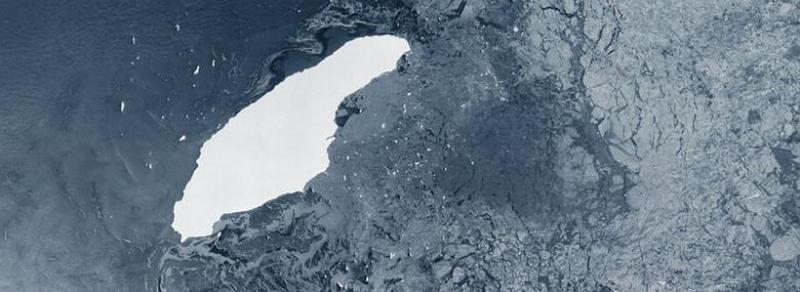 In July 2017, we posted about the calving of a massive iceberg from Antarctica’s Larsen C ice-shelf. The iceberg, which would be designated as A68a, is the world’s biggest iceberg, weighing roughly one trillion tons and measuring 4,200 sq km, or almost the size of the state of Delaware.
In July 2017, we posted about the calving of a massive iceberg from Antarctica’s Larsen C ice-shelf. The iceberg, which would be designated as A68a, is the world’s biggest iceberg, weighing roughly one trillion tons and measuring 4,200 sq km, or almost the size of the state of Delaware.
At first, A68a stayed more or less stationary, temporarily aground close to the ice-shelf. In July, it broke free and started to drift. There is now a real concern that A68a is on a collision course with the British Overseas Territory of South Georgia. The massive berg is roughly the same length as South Georgia island itself. There is now a strong possibility that the berg could ground and anchor itself offshore of the wildlife haven. If that happens, it poses a grave threat to local penguins and seals.
As reported by the BBC,The animals’ normal foraging routes could be blocked, preventing them from feeding their young properly.
And it goes without saying that all creatures living on the seafloor would be crushed where A68a touched down – a disturbance that would take a very long time to reverse.
“Ecosystems can and will bounce back of course, but there’s a danger here that if this iceberg gets stuck, it could be there for 10 years,” said Prof Geraint Tarling from the British Antarctic Survey (BAS).
“And that would make a very big difference, not just to the ecosystem of South Georgia but its economy as well,” he told BBC News.
When the huge berg A38 grounded at South Georgia in 2004, countless dead penguin chicks and seal pups were found on local beaches.
While A68a appears to be heading straight for South Georgia, anything could happen. If it drifts past the island and continues north, it should start breaking up once it gets into warmer waters.
Thanks to David Rye for contributing to this post.

Just what Shackleton and his crew could have done with a ride on, rather than sailing his tiny boat.